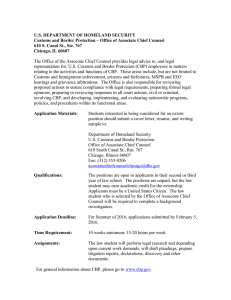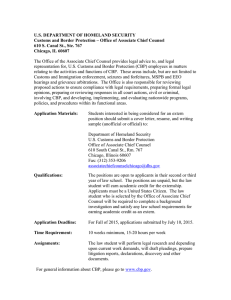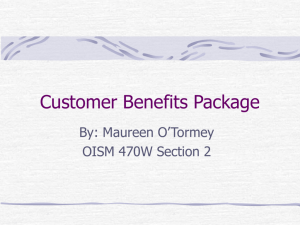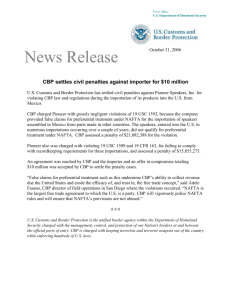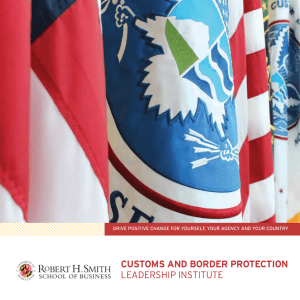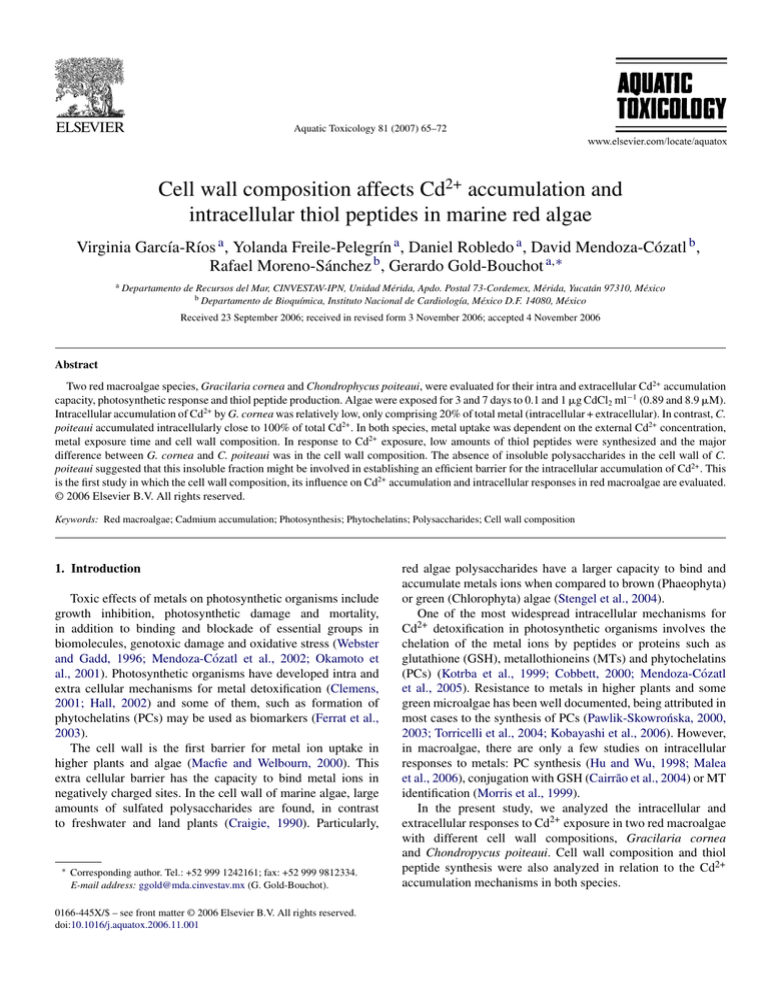
Aquatic Toxicology 81 (2007) 65–72
Cell wall composition affects Cd2+ accumulation and
intracellular thiol peptides in marine red algae
Virginia Garcı́a-Rı́os a , Yolanda Freile-Pelegrı́n a , Daniel Robledo a , David Mendoza-Cózatl b ,
Rafael Moreno-Sánchez b , Gerardo Gold-Bouchot a,∗
a
Departamento de Recursos del Mar, CINVESTAV-IPN, Unidad Mérida, Apdo. Postal 73-Cordemex, Mérida, Yucatán 97310, México
b Departamento de Bioquı́mica, Instituto Nacional de Cardiologı́a, México D.F. 14080, México
Received 23 September 2006; received in revised form 3 November 2006; accepted 4 November 2006
Abstract
Two red macroalgae species, Gracilaria cornea and Chondrophycus poiteaui, were evaluated for their intra and extracellular Cd2+ accumulation
capacity, photosynthetic response and thiol peptide production. Algae were exposed for 3 and 7 days to 0.1 and 1 g CdCl2 ml−1 (0.89 and 8.9 M).
Intracellular accumulation of Cd2+ by G. cornea was relatively low, only comprising 20% of total metal (intracellular + extracellular). In contrast, C.
poiteaui accumulated intracellularly close to 100% of total Cd2+ . In both species, metal uptake was dependent on the external Cd2+ concentration,
metal exposure time and cell wall composition. In response to Cd2+ exposure, low amounts of thiol peptides were synthesized and the major
difference between G. cornea and C. poiteaui was in the cell wall composition. The absence of insoluble polysaccharides in the cell wall of C.
poiteaui suggested that this insoluble fraction might be involved in establishing an efficient barrier for the intracellular accumulation of Cd2+ . This
is the first study in which the cell wall composition, its influence on Cd2+ accumulation and intracellular responses in red macroalgae are evaluated.
© 2006 Elsevier B.V. All rights reserved.
Keywords: Red macroalgae; Cadmium accumulation; Photosynthesis; Phytochelatins; Polysaccharides; Cell wall composition
1. Introduction
Toxic effects of metals on photosynthetic organisms include
growth inhibition, photosynthetic damage and mortality,
in addition to binding and blockade of essential groups in
biomolecules, genotoxic damage and oxidative stress (Webster
and Gadd, 1996; Mendoza-Cózatl et al., 2002; Okamoto et
al., 2001). Photosynthetic organisms have developed intra and
extra cellular mechanisms for metal detoxification (Clemens,
2001; Hall, 2002) and some of them, such as formation of
phytochelatins (PCs) may be used as biomarkers (Ferrat et al.,
2003).
The cell wall is the first barrier for metal ion uptake in
higher plants and algae (Macfie and Welbourn, 2000). This
extra cellular barrier has the capacity to bind metal ions in
negatively charged sites. In the cell wall of marine algae, large
amounts of sulfated polysaccharides are found, in contrast
to freshwater and land plants (Craigie, 1990). Particularly,
∗
Corresponding author. Tel.: +52 999 1242161; fax: +52 999 9812334.
E-mail address: ggold@mda.cinvestav.mx (G. Gold-Bouchot).
0166-445X/$ – see front matter © 2006 Elsevier B.V. All rights reserved.
doi:10.1016/j.aquatox.2006.11.001
red algae polysaccharides have a larger capacity to bind and
accumulate metals ions when compared to brown (Phaeophyta)
or green (Chlorophyta) algae (Stengel et al., 2004).
One of the most widespread intracellular mechanisms for
Cd2+ detoxification in photosynthetic organisms involves the
chelation of the metal ions by peptides or proteins such as
glutathione (GSH), metallothioneins (MTs) and phytochelatins
(PCs) (Kotrba et al., 1999; Cobbett, 2000; Mendoza-Cózatl
et al., 2005). Resistance to metals in higher plants and some
green microalgae has been well documented, being attributed in
most cases to the synthesis of PCs (Pawlik-Skowrońska, 2000,
2003; Torricelli et al., 2004; Kobayashi et al., 2006). However,
in macroalgae, there are only a few studies on intracellular
responses to metals: PC synthesis (Hu and Wu, 1998; Malea
et al., 2006), conjugation with GSH (Cairrão et al., 2004) or MT
identification (Morris et al., 1999).
In the present study, we analyzed the intracellular and
extracellular responses to Cd2+ exposure in two red macroalgae
with different cell wall compositions, Gracilaria cornea
and Chondropycus poiteaui. Cell wall composition and thiol
peptide synthesis were also analyzed in relation to the Cd2+
accumulation mechanisms in both species.
66
V. Garcı́a-Rı́os et al. / Aquatic Toxicology 81 (2007) 65–72
2. Materials and methods
2.5. HPLC analysis of intracellular thiols
2.1. Cd2+ exposure
Algal samples were homogenized with a mortar and pestle
in liquid nitrogen and 1.5 ml of 50 mM Tris–HCl buffer (pH 8),
containing 1 mM EGTA. The homogenate was centrifuged for
20 min at 4 ◦ C and 50,000 × g. The supernatant was kept under
reduced conditions by adding DTT (2 mM final concentration),
mixed and centrifuged again for 20 min at 4 ◦ C and 50,000 × g.
Proteins were precipitated with perchloric acid (3% final concentration), vortexed and centrifuged as described before. The clear
supernatant was filtered (using 0.22 m pore diameter cut-off
filters, Millex Millipore) and injected into a Spherisorb column (C18, reverse phase, 5 ODS 2, 4.6 mm × 150 mm). The
column was equilibrated with trifluoracetic acid (0.1%) and peptides were eluted in a 0–20% acetonitrile linear gradient at a
flow rate of 1 ml min−1 . Post-column derivatization with Ellman’s reagent was used to detect thiol-containing compounds at
412 nm, as described elsewhere (Rauser, 1991). A synthesized
PC2 standard was used to identify PC-related compounds.
Unialgal cultures of G. cornea and C. poiteaui were established in a culture chamber under laboratory conditions at 23 ◦ C,
80 mol photons m−2 s−1 and 12-h light:12-h dark photoperiod
with natural sea water filtered through 1.2 m Millipore filters
and 33‰ salinity. Macroalgae were grown in 1000 ml cylinders
for 3–7 days in the presence of 0.1 or 1 g CdCl2 ml−1 in natural sea water, corresponding to 0.89 and 8.9 M, respectively.
Control cultures with no Cd2+ added to the culture media were
also carried out.
2.2. Total and intracellular Cd2+ quantification
After 3 and 7 days at the indicated added CdCl2 concentrations, algae were collected and rinsed with distilled water.
Samples for the determination of intracellular Cd2+ were rinsed
twice for 10 min with water containing 5 mM EDTA (pH 8)
to remove metals adsorbed by the cell wall. Thereafter, the
samples were freeze–dried for determination of total (waterrinsed) and intracellular accumulated Cd2+ (EDTA-rinsed) and
dry weight. Metal content in the macroalgae was determined
with a Perkin-Elmer SIMAA 6100 graphite furnace atomic
absorption spectrophotometer. Samples of an Ulva lactuca certified reference material (BCR Reference No. 279, Commission
of the European Communities) were also analyzed with every
batch of samples, with an average 98% recovery with respect to
the Cd2+ certified concentration.
2.6. Data analysis
Statistical analysis of data was carried out with STATISTICA
software (Version 6, StatSoft, Inc., 2003). To determine significant differences in treatments, a non-parametric Kruskal–Wallis
analysis of variance was used. The significant level was established at α = 0.05. Data is presented as the median of four
independent replicates ± one interquartile range.
3. Results
2.3. Cell wall polysaccharides analysis
3.1. Total and intracellular Cd2+ quantification
Macroalgal tissue was freeze–dried, pulverized, and incubated in 0.1 M sodium acetate buffer (pH 6), 5 mM EDTA,
5 mM cysteine and 0.5 mg papain. Sulfated polysaccharides
were precipitated with 10% cetylpyridinium chloride (adapted
from Farias et al., 2000). Soluble sulfated polysaccharides were
separated from the insoluble fraction after dissolving with distilled water and further filtrating through a sintered-glass plate
(4.0–5.5 m pore size). Fractions obtained were freeze–dried
and weighed (Melo et al., 2002). The sulfate content of polysaccharides was determined by a turbidimetric method (Jackson
and McCandless, 1978).
Cd2+ uptake in G. cornea and C. poiteaui was proportional
to the CdCl2 concentration added to the culture medium and
to the time of exposure (Table 1). Both G. cornea and C.
poiteaui exhibited a high uptake when exposed for 7 days to
1 g CdCl2 ml−1 . C. poiteaui accumulated four-fold more Cd2+
than G. cornea (Table 1). However, most of the metal found
in G. cornea was allocated extracellularly (80%). Interestingly,
C. poiteaui accumulated most of the Cd2+ inside the cell (near
100% of total Cd2+ ). Both G. cornea and C. poiteaui exhibited
a higher uptake when exposed to 1 g CdCl2 ml−1 and after 7
days exposure.
2.4. Photosynthesis light–response curves
3.2. Cell wall polysaccharides analysis
Photosynthetic responses in macroalgae exposed to Cd2+
were measured. Photosynthesis measurements were performed
in a DW/2 chamber at 21 ◦ C using a Clark-type oxygen electrode and the Oxygraph program (Hansatech, King’s Lynn, UK).
After equilibration in darkness for 3 min, respiration rate was
measured as O2 consumption. Oxygen evolution was measured
during periods of 2 min at light intensities, varying from 50 to
1400 mol photons m−2 s−1 . Maximal net photosynthetic activity (Pmax ) was calculated for each individual sample from their
photosynthetic light–response curves (Henley, 1993).
Content of soluble and insoluble polysaccharide in G. cornea
and C. poiteaui is shown in Fig. 1. For G. cornea, polysaccharides constituted 35 ± 7% of total dry wt, 50% of which were
soluble and 50% insoluble. In this species, no significant changes
in the soluble/insoluble ratio were found after 3 or 7 days of
exposure. In C. poiteaui, a lower polysaccharide content was
obtained (23 ± 3% of total dry wt) when compared to G. cornea,
but a marked difference between these species was the negligible
content of the insoluble polysaccharide fraction in C. poiteaui
(Fig. 1).
V. Garcı́a-Rı́os et al. / Aquatic Toxicology 81 (2007) 65–72
67
Table 1
Total and intracellular Cd2+ accumulation (g g−1 dry wt) and total thiol peptide concentrations (nmol SH mg−1 dry wt) in G. cornea and C. poiteaui
Exposure conditions
G. cornea
Control
3 days
7 days
Total Cd2+
Intracellular Cd2+
Total thiol
0.4 ± 0.4
0.4 ± 0.1
0.5 ± 0.5
0.14 ± 0.05
0.7 ± 0.2
0.8 ± 0.5
0.1 g Cd ml−1
3 days
7 days
3.4 ± 2
6±1
1.4 ± 0.7
1.1 ± 0.7
0.7 ± 0.4
0.81 ± 0.17
1 g Cd ml−1
3 days
7 days
14.9 ± 2.7a
22.9 ± 2.7a
3 ± 1.6a
5 ± 1.8
0.8 ± 0.3
1 ± 0.7
H = 9.846
p = 0.007
H = 9.269
p = 0.020
H = 0.356
p = 0.837
H = 9.846
p = 0.007
H = 4.718
p = 0.094
H = 0.089
p = 0.956
Kruskal–Wallis test
3 days
7 days
Exposure conditions
C. poiteaui
Control
3 days
7 days
Total Cd2+
Intracellular Cd2+
Total thiol
Thiol peptides
PC2
X1
0.02 ± 0.03
0.09 ± 0.10
0.01 ± 0.01
Thiol peptides
PC2
X1
X2
0.19 ± 0.03
0.18 ± 0.03
0.24 ± 0.10
0.33 ± 0.04
1.0 ± 0.9
0.47 ± 0.5
0.1 g Cd ml−1
3 days
7 days
14 ± 4.6
21 ± 2
14 ± 3.1
23.5 ± 1.4
1.0 ± 0.5
0.64 ± 1.44
0.01 ± 0.00
0.01 ± 0.01
0.01 ± 0.01
0.01 ± 0.02
0.02 ± 0.01
0.02 ± 0.01
1 g Cd ml−1
3 days
7 days
78.6 ± 23a
93.4 ± 11a
72 ± 25a
64 ± 12a
1.43 ± 0.61
1.07 ± 0.23
0.03 ± 0.01a
0.03 ± 0.03
0.02 ± 0.01
0.03 ± 0.02a
0.02 ± 0.01a
0.02 ± 0.01
H = 7.854
p = 0.020
H = 8.910
p = 0.012
H = 0.694
p = 0.707
H = 6.562
p = 0.038
H = 5.833
p = 0.054
H = 6.562
p = 0.038
H = 9.846
p = 0.007
H = 9.846
p = 0.007
H = 2.472
p = 0.290
H = 5.426
p = 0.066
H = 6.325
p = 0.042
H = 4.076
p = 0.130
Kruskal–Wallis test
3 days
7 days
Median ± quartile range; n = 4.
a Significant difference with respect to control.
In the control group (no Cd2+ exposure), polysaccharide sulfate content was 2.6 times higher in C. poiteaui
(20 ± 5 g sulfate mg−1 polysaccharide) than in G. cornea
(7.7 ± 2 g sulfate mg−1 polysaccharide; Fig. 2). Soluble
polysaccharides in G. cornea had a significant increase in sulfate
content after 3 days exposure to 0.1 g CdCl2 ml−1 ; after 7 days
exposure, sulfate content returned back to basal levels (Fig. 2). C.
poiteaui did not show any significant changes in polysaccharides
sulfate content after 3 or 7 days of Cd2+ exposure.
3.3. Photosynthetic parameters
Maximal photosynthesis (Pmax ) values in G. cornea and C.
poiteaui are shown in Fig. 3. No significant differences in Pmax
were observed in G. cornea between treatments after 3 and
7 days of CdCl2 exposure (Fig. 3). On the other hand, in C.
poiteaui, exposure to 1 g CdCl2 ml−1 caused a considerable
decrease of Pmax after 3 days (Fig. 3). After 7 days, Pmax values
returned to control levels without significant differences with
the control group.
3.4. Intracellular thiols
After 3 days exposure of G. cornea to 1 g CdCl2 ml−1 , small
production of thiol-peptides with similar HPLC retention time
to phytochelatin-2 (PC2 ) was detected; after 7 days exposure,
a second thiol-peptide with a longer retention time was also
detected (X1 ), suggesting the occurrence of larger PCs in G.
cornea (Fig. 4). However, no significant difference in total thiol
content in G. cornea was observed (Table 1).
In C. poiteaui, after 3 days exposure to 0.1 or
1 g CdCl2 ml−1 , three thiol peptides were found (Fig. 5). The
68
V. Garcı́a-Rı́os et al. / Aquatic Toxicology 81 (2007) 65–72
Fig. 1. Total, soluble and insoluble polysaccharides content in G. cornea and absence of insoluble polysaccharides in C. poiteaui exposed to 0, 0.1 and 1 g CdCl2 ml−1
in the seawater. Median ± one interquartile range (n = 4). * Significant differences with respect to control in C. poiteaui (H = 7.848; p = 0.020).
first compound exhibited a retention time similar to PC2 ; two
other compounds with higher retention times, possibly larger
PCs, were also detected and quantified (X1 and X2 ). There
was a significant increase in the content of these Cd2+ induced
thiol-peptides after 3 and 7 days of Cd2+ exposure (Table 1).
Although C. poiteaui exhibited a higher number of different
thiol-compounds than G. cornea, the content of thiol peptides
did not show significant changes between treatments.
Fig. 2. Increase and recovery of sulfate content in polysaccharides of G. cornea and C. poiteaui exposed to 0, 0.1 and 1 g CdCl2 ml−1 in the seawater. Median ± one
interquartile range (n = 4). * Significant differences with respect to control in G. cornea (H = 6.727; p = 0.035).
V. Garcı́a-Rı́os et al. / Aquatic Toxicology 81 (2007) 65–72
69
Fig. 3. Maximal photosynthesis (Pmax ) of: (A) G. cornea and (B) C. poiteaui after 3 days (grey bars) and 7 days (stripped bars) exposure to 0, 0.1 and 1 g CdCl2 ml−1 .
Median ± one interquartile range (n = 4). * Significant differences with respect to control of C. poiteaui (H = 7.385; p = 0.025).
4. Discussion
4.1. Cd2+ uptake
The different capacity to accumulate Cd2+ by G. cornea and
C. poiteaui, extra and intracellularly indicated that these species
have different protection mechanisms developed against metal
exposure. Apparently, the complex polysaccharides of the G.
cornea cell wall were an efficient barrier to avoid metal toxicity,
thus leading to a low intracellular metal accumulation. G. cornea
showed a limited capacity to accumulate Cd2+ intracellularly,
while extracellular binding correlated with the CdCl2 concentration in the medium. In contrast, C. poiteaui predominantly
accumulated Cd2+ intracellularly, and this process correlated
with the Cd2+ concentration and time of exposure, although it
is worth noting that the metal accumulation–CdCl2 concentration relationship was not lineal. Moreover, C. poiteaui showed a
marked cellular response to the metal exposure regarding photosynthesis and production of thiol peptides. On this regard, Wang
and Dei (1999) indicated that metal uptake in Gracilaria blodgettii was higher at lower metal concentration in the medium.
Metal uptake is determined by the physical and chemical
characteristics of the metal ion, and by the biological characteristics of the exposed organisms (Ariza et al., 1999). Maximal total
Cd2+ accumulation in C. poiteaui (93.5 g g−1 dry wt) and G.
cornea (22.9 g g−1 dry wt) was far below data obtained in other
Fig. 4. Representative chromatograms of thiol peptides of G. cornea exposed to 0, 0.1 and 1 g CdCl2 ml−1 in the seawater.
70
V. Garcı́a-Rı́os et al. / Aquatic Toxicology 81 (2007) 65–72
Fig. 5. Representative chromatograms of thiol peptides of C. poiteaui exposed to 0, 0.1 and 1 g CdCl2 ml−1 in the seawater.
studies with microalgae and brown macroalgae. For example, in
Chlamydomonas reinhartii, Cd2+ accumulation (Kobayashi et
al., 2006) was 500 and 1800-fold higher than that obtained by
C. poiteaui and G. cornea, respectively, at similar added Cd2+
concentrations in the medium. In Fucus serratus, copper accumulation reached 1000 g g−1 dry wt when exposed to 0.8 M
copper (Nielsen et al., 2003).
4.2. Cell wall polysaccharide and sulfur content
No evident changes in soluble or insoluble polysaccharides
content were found after Cd2+ exposure in G. cornea. In contrast, soluble polysaccharides in C. poiteaui decreased after
7 days of exposure to both Cd2+ concentrations used. This
response may be explained by intracellular metal accumulation and the associated perturbation of cellular functions. In
G. cornea, its high content of cell wall insoluble polysaccharides might have facilitated the extracellular binding of Cd2+ and
hence intracellular synthesis of the cell wall and other intracellular processes remained protected. On the other hand, absence
of cell wall insoluble polysaccharides in C. poiteaui correlated
with a negligible external Cd2+ binding and significant intracellular accumulation of Cd2+ , thus inducing alteration in cell wall
synthesis and other intracellular functions.
It has not been clearly established whether cell wall composition determines metal accumulation, or it plays a protective
role in microalgae. On this regard, increased polysaccharide
production and low resistance, or moderate production of
polysaccharides and very efficient exclusion mechanisms have
been observed in phytoplankton by Pistocchi et al. (2000). In two
Chlamydomonas reinhardtii strains, variation in the composition of the cell wall did not correlate with the different tolerance
to metal toxicity (Macfie and Welbourn, 2000). A comparison
of Cd2+ bio-absorption capacity among different macroalgae
showed that alginic acid in the cell wall of brown macroalgae
was more efficient to bind Cd2+ than polysaccharides found in
red or green macroalgae (Hashim and Chu, 2004). In contrast,
Stengel et al. (2004) showed that red macroalgae were more efficient to accumulate zinc than the other algal groups. The lack
of insoluble polysaccharides in C. poiteaui (see Fig. 1) may be
related to the observed high intracellular accumulation of Cd2+
in this species; however, more studies are necessary to determine the role of cell wall insoluble polysaccharides of red algae
in Cd2+ accumulation.
Although sulfur containing compounds are responsible for
Cd2+ chelation in brown algae (Raize et al., 2004), sulfate content was not related to the extracellular Cd2+ binding capacity
between the two species used in the present study. C. poiteaui
exhibited higher polysaccharide sulfate content; however, it did
not retain Cd2+ in the cell wall. On the contrary, sulfate content
in the soluble fraction of G. cornea polysaccharides increased
after 3 days of Cd2+ exposure, returned to basal concentrations
after 7 days. Seasonal sulfate content changes occurred in G.
cornea (Freile-Pelegrin and Robledo, 1997). Increased sulfate
content could be related to a general cell response to stress of
multiple origins and not to a specific protective response to Cd2+
exposure.
4.3. Cellular response to Cd2+
Accumulation of Cd2+ in chloroplasts and its effects on photosynthesis have been documented in microalgae (Okamoto et
al., 2001; Mendoza-Cózatl et al., 2002). In Gonyaulax polyedra,
acute exposure to Cd2+ generated oxidative stress in the chloro-
V. Garcı́a-Rı́os et al. / Aquatic Toxicology 81 (2007) 65–72
plasts, whereas under chronic exposure the antioxidant system
was able to protect (Okamoto et al., 2001). The decrease of Pmax
in C. poiteaui after 3 days of exposure and its recover after 7
days may reflect the activation of the antioxidant system. Analysis of the degree of oxidative stress and antioxidant enzymes
activity are necessary to determine the effect of metal exposure
on photosynthetic responses. On this issue, Pmax recovery in
C. poiteaui after 7 days of Cd2+ exposure may be related to
metal detoxification mechanisms. This suggestion is consistent
with the synthesis of thiol-peptides beginning after 3 days and
increasing after 7 days of Cd2+ exposure. As PC synthesis was
induced at low, almost negligible levels, it may be proposed that
PC synthesis is not a significant part of the Cd2+ detoxification
mechanisms in this species. Higher induction of PC synthesis in
microalgae exposed to Cd2+ concentrations similar to those used
in this study has been previously reported (Mendoza-Cózatl et
al., 2005; Kobayashi et al., 2006), as well as after exposure to
other metals such as zinc and lead (Pawlik-Skowrońska, 2000,
2003; Tsuji et al., 2003).
GSH is the major reservoir (up to 90%) of non-proteic sulfur
in the cell, and is the substrate for PC synthesis. Consumption
of GSH by PC synthesis induces an increase in the rate of GSH
synthesis to restore basal levels. For that reason, depending on
the GSH demand rate, GSH levels may increase or decrease after
Cd2+ exposure (reviewed by Mendoza-Cózatl et al., 2005). In our
results, total thiol content did not change with Cd2+ exposure;
in other words, there was no significant PC synthesis. In the two
marine macroalgae analyzed in the present study, Cd2+ exposure
caused a low PC synthesis without GSH depletion.
No significant synthesis of PCs in G. cornea and C. poiteaui
was achieved at the low intracellular Cd2+ concentration accumulated. In higher plants and some yeast, the number of Cd2+
ions bound by the thiol group is variable (<1–4), and depends on
the thiol-compound chemical nature (i.e. GSH, PCs, etc.) (Zenk,
1996). In the present study, the thiol group content/intracellular
Cd2+ ratio in C. poiteaui was 2:1, which suffices to chelate all
intracellular Cd2+ without PC synthesis, although Cd2+ should
not be fully inactivated as a thiol/Cd2+ ratio of 4 is required. This
response suggests that red macroalgae have detoxification mechanisms that involve active plasma membrane metal uptake, and
an efficient intracellular metal binding by compounds other than
PCs, perhaps smaller thiol-compounds. A low PC induction has
also been observed in the green macroalgae Enteromorpha spp.
(Malea et al., 2006). Other possible intracellular mechanisms
different to PCs may also be responsible for metal detoxification in some marine macroalgae. Non-protein reduced sulfur like
cysteine and glutathione might be the major thiol compounds
involved in the detoxification of all intracellular Cd2+ in this
macroalgae whereas PCs may play only a minor role.
5. Conclusions
Soluble and insoluble polysaccharides present in the cell wall
of G. cornea bound most of the Cd2+ extracellularly. The absence
of insoluble polysaccharides in the cell wall of C. poiteaui was
the major difference when compared to the G. cornea cell wall.
In C. poiteaui, most of the Cd2+ was accumulated intracellularly,
71
which however did not induce a significant PC synthesis and
therefore other detoxification mechanisms may be involved. The
recovery of the photosynthetic performance of C. poiteaui after
7 days of Cd2+ exposure suggested the activation of intracellular
detoxification mechanisms. However, more studies on oxidative
stress and antioxidant enzymes activity are required to determine
the effect of metal exposure on these physiological responses.
Acknowledgements
The present work was partially supported by grants
43811-Q from CONACYT-México and 2002-C01-1057 from
CONACYT-SAGARPA. We appreciate C. Chavez, M. Zaldivar and V. Ceja for their contribution in the polysaccharides,
photosynthesis and metal analysis. We thank deeply Dr. Peter
Chapman for his valuable comments.
References
Ariza, M.E., Bijur, G.N., Williams, M.V., 1999. Environmental Metal Pollutants, Reactive Oxygen Intermediaries and Genotoxicity. Kluwer Academic
Publishers, Boston, USA.
Cairrão, E., Couderchet, M., Soares, A.M.V.M., Guilhermino, L., 2004.
Glutathione-S-transferase activity of Fucus spp. as a biomarker of environmental contamination. Aquat. Toxicol. 70, 277–286.
Clemens, S., 2001. Molecular mechanisms of plant metal tolerance and homeostasis. Planta 212, 475–486.
Cobbett, C.S., 2000. Phytochelatins and their roles in heavy metal detoxification.
Plant Physiol. 123, 825–832.
Craigie, J.S., 1990. Cell walls. In: Kathleen, M.C., Robert, G.S. (Eds.), Biology
of the Red Algae. Cambridge University Press, pp. 221–258.
Farias, W.R.L., Valente, A.P., Pereira, M.S., Mourao, P.A.S., 2000. Structure and anticoagulant activity of sulfated galactans. J. Biol. Chem. 275,
29299–29307.
Ferrat, L., Pergent-Martini, C., Roméo, M., 2003. Assessment of the use of
biomarkers in aquatic plants for the evaluation of environmental quality:
application to seagrasses. Aquat. Toxicol. 65, 187–204.
Freile-Pelegrin, Y., Robledo, D., 1997. Effects of season on the agar content
and chemical characteristics of Gracilaria cornea from Yucatan, Mexico.
Botanica Marina 40, 285–290.
Hall, J.L., 2002. Cellular mechanisms for heavy metal detoxification and tolerance. J. Exp. Bot. 53, 1–11.
Hashim, M.A., Chu, K.H., 2004. Biosorption of cadmium by brown, green, and
red seaweeds. Chem. Eng. J. 97, 249–255.
Henley, W.J., 1993. Measurement and interpretation of photosynthetic light
response curves in algae in the context of photoinhibition and diel changes.
J. Phycol. 29, 729–739.
Hu, S., Wu, M., 1998. Cadmium sequestration in the marine macroalga Kappaphycus alvarezii. Mol. Mar. Biol. Biotechnol. 7, 97–104.
Jackson, S.G., McCandless, E.L., 1978. Simple, rapid, turbidometric determination of inorganic sulfate and/or protein. Anal. Biochem. 90, 802–808.
Kobayashi, I., Fujiwara, S., Saegusa, H., Inouhe, M., Matsumoto, H., Tsuzuki,
M., 2006. Relief of arsenate toxicity by Cd-stimulated phytochelatin synthesis in the green alga Chlamydomonas reinhardtii. Mar. Biotechnol. 8,
94–101.
Kotrba, P., Macek, T., Ruml, T., 1999. Heavy metal-binding peptides and proteins
in plants: a review. Collect. Czech. Chem. Commun. 64, 1057–1086.
Macfie, S.M., Welbourn, P.M., 2000. The cell wall as a barrier to uptake of
metal ions in the unicellular green alga Chlamydomonas reinhardtii (Chlorophyceae). Arch. Environ. Contam. Toxicol. 39, 413–419.
Malea, P., Rijstenbil, J.W., Haritonidis, S., 2006. Effects of cadmium, zinc and
nitrogen status on non-protein thiols in the macroalgae Enteromorpha spp.
from the Scheldt Estuary (SW Netherlands, Belgium) and Thermaikos Gulf
(N Aegean Sea, Greece). Mar. Environ. Res. 62, 45–60.
72
V. Garcı́a-Rı́os et al. / Aquatic Toxicology 81 (2007) 65–72
Melo, M.R.S., Feitosa, J.P.A., Freitas, A.L.P., De Paula, R.C.M., 2002. Isolation
and characterization of soluble sulfated polysaccharide from the red seaweed
Gracilaria cornea. Carbohydr. Polym. 49, 491–498.
Mendoza-Cózatl, D., Devars, S., Loza-Tavera, H., Moreno-Sánchez, R., 2002.
Cadmium accumulation in the chloroplast of Euglena gracilis. Physiol.
Plant. 115, 276–283.
Mendoza-Cózatl, D., Loza-Tavera, H., Hernández-Navarro, A., MorenoSánchez, R., 2005. Sulfur assimilation and glutathione metabolism under
cadmium stress in yeast, protists and plants. FEMS Microbiol. Rev. 29,
653–671.
Morris, C.A., Nicolaus, B., Sampson, V., Harwood, J.L., Kille, P., 1999. Identification and characterization of a recombinant metallothionein protein from
a marine alga, Fucus vesiculosus. Biochem. J. 338, 553–560.
Nielsen, H.D., Brownlee, C., Coelho, S.M., Brown, M.T., 2003. Inter-population
differences in inherited copper tolerance involve photosynthetic adaptation
and exclusion mechanisma in Fucus serratus. New Phytol. 160, 157–165.
Okamoto, O.K., Pinto, E., Latorre, L.R., Bechara, E.J.H., Colepicolo, P., 2001.
Antioxidant modulation in response to metal-induced oxidative stress in
algal chloroplasts. Arch. Environ. Contam. Toxicol. 40, 18–24.
Pawlik-Skowrońska, B., 2000. Relationships between acid-soluble thiol peptides and accumulated Pb in the green alga Stichococcus bacillaris. Aquat.
Toxicol. 50, 221–230.
Pawlik-Skowrońska, B., 2003. When adapted to high zinc concentrations the
periphytic green alga Stigeoclonium tenue produces high amounts of novel
phytochelatin-related peptides. Aquat. Toxicol. 62, 155–163.
Pistocchi, R., Mormile, A.M., Guerrini, F., Isani, G., Boni, L., 2000. Increased
production of extra- and intracellular metal-ligands in phytoplankton
exposed to copper and cadmium. J. Appl. Phycol. 12, 469–477.
Raize, O., Argaman, Y., Yannai, S., 2004. Mechanisms of biosorption of different heavy metals by brown marine macroalgae. Biotechnol. Bioeng. 87,
451–458.
Rauser, W.E., 1991. Cadmium-binding peptides from plants. Methods Enzymol.
205, 319–333.
Stengel, D.B., Macken, A., Morrison, L., Morley, N., 2004. Zinc concentrations
in marine macroalgae and lichen from western Ireland in relation to phylogenetic grouping, habitat and morphology. Mar. Poll. Bull. 48, 902–909.
Torricelli, E., Gorbi, G., Pawlik-Skowrońska, B., di Toppi, L.S., Corradi, M.G.,
2004. Cadmium tolerance, cysteine and thiol peptide levels in wild type and
chromium-tolerant strains of Scenedesmus acutus (Chlorophyceae). Aquat.
Toxicol. 68, 315–323.
Tsuji, N., Hirayanagi, N., Iwabe, O., Namba, T., Tagawa, M., Miyamoto, S.,
Miyasaka, H., Takagi, M., Hirata, K., Miyamoto, K., 2003. Regulation
of phytochelatin synthesis by zinc and cadmium in marine green alga,
Dunaliella tertiolecta. Phytochemistry 62, 453–459.
Wang, W.X., Dei, R.C.H., 1999. Kinetic measurements of metal accumulation
in two marine macroalgae. Mar. Biol. 135, 11–23.
Webster, E.A., Gadd, G.M., 1996. Perturbation of monovalent cation composition in Ulva lactuca by cadmium, copper and zinc. BioMetals 9, 51–56.
Zenk, M.H., 1996. Heavy metal detoxification in higher plants—a review. Gene
179, 21–30.



